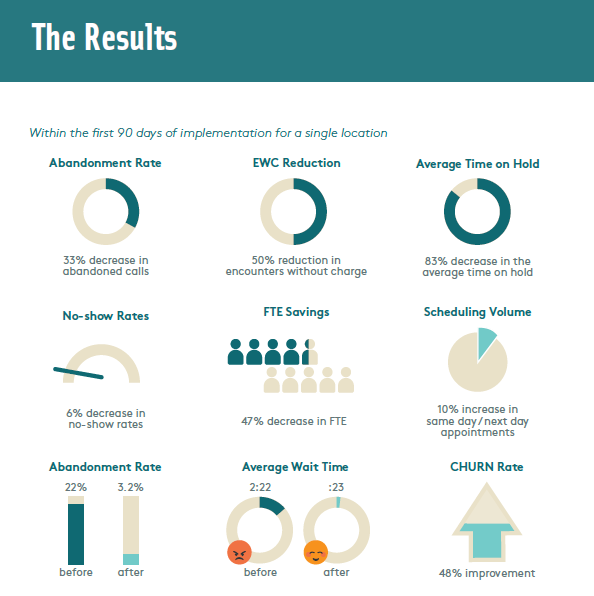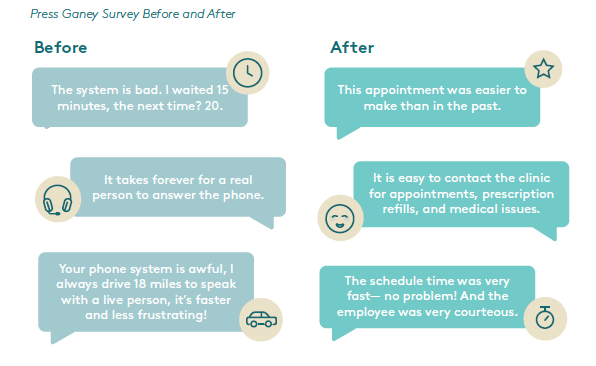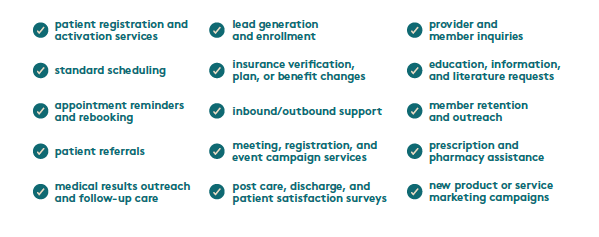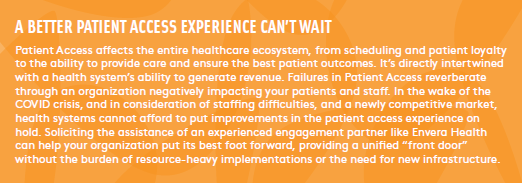Case Study
Large Health System Dials In The Patient Access Experience
Organization Type
Health System
Geographic Region
Midwest
Organization Size
8 hospitals
1000 physicians
60+ specialties
serving a patient
population of over 500k
Pressed for Time?
Watch the video to the right and get this content in 30 seconds — then come back for a deeper dive by scrolling to the full version below. Or let our AI concierge, Haxall, know you would like to download a pdf version of this case study so you can review it at a later time.
Large Health System Dials In The Patient Access Experience
THE CHALLENGE
The health system was beginning to experience reputational harm from negative patient sentiment due to a severely fractured patient access experience. Patients were regularly disrupting time with physicians to complain about difficulties during the patient access process, citing long wait times and the necessity to transfer multiple times between Patient Service Representatives (PSRs). Patient surveys conducted by Press Ganey reinforced this assessment by identifying a confusing phone tree and long call wait times as primary patient complaints. Desperate to get a live person on the phone, patients would intentionally utilize the wrong option on the phone tree in order to request a transfer to Scheduling— a coping mechanism that extended difficulties in patient access to other departments. Call performance metrics supported patient sentiment, showing abandonment rates over 20%, long hold times, and a high volume of transfers. Subsequently, individual offices were experiencing an uptick in no-shows that were impacting their ability to efficiently fill the schedule, resulting in scheduling volumes that did not reflect the market demand.
THE DISCOVERY
During Envera’s discovery process the underlying factors responsible for the poor access experience were revealed. A large portion of the problem rested on the decentralized nature of the health system’s phone strategy which stifled patient access efforts through the use of multiple varied contact numbers, phone trees and EMR systems across several locations. This strategy complicated the ability of patients to reach the proper department for assistance which resulted in long hold times, the necessity for transfer, or, unfortunately, large volumes of patient calls being sent to voicemail. It was apparent that difficulties in this area were responsible for the high call abandonment and no-shows as patients would simply hang up rather than endure the process to cancel or reschedule appointments. Additionally, Envera was able to identify CHURN rates (the rate of calls to appointments) that were nearly double that of the national average. The overcomplicated phone strategy was exacerbated by staffing issues, contributing further to the problems in patient access. Existing Patient Service Representatives (PSRs) were stretched very thin between juggling point of care and patient access task — the difficulty of trying to field calls and manage the schedule in addition to the attention required to accurately assist the patients in front of them with registration, check-in, and paperwork had PSRs neglecting the phones out of necessity. Operational frustrations from staff were contributing to the long waits and a negative patient experience.
Ultimately, the decentralization of the phone strategy put a burden on internal processes and the care delivery process, impacting the ability to provide a high level of patient care both in-person and on the phone.
THE SOLUTION
Envera Health developed a custom Patient Access solution based on the pain points and specific needs of the health system. The issue of staffing was remedied by establishing a dedicated team of Patient Access Coordinators (PACs), trained to tackle the unique preferences and processes for each individual location. Additionally, Envera’s PACs utilize a one-touch strategy that is designed to anticipate patient needs and resolve multiple requests across several departments on the same call. This more efficient approach to patient engagement not only improves scheduling volumes but results in better patient outcomes over time. With the help of the PACs, the health system’s PSRs were freed from the burden of schedule management and routine inquiries allowing them to provide better point-of-care service which resulted in across-the-board improvements in the patient experience. To solve the issues around decentralization, Envera instituted a completely reimagined strategy from phone tree redesign to the standardization of processes related to patient access. The solution was designed to work within the health system’s unique workflows, making implementation simple, and allowing for interfacing with all their existing systems. This meant PACs could receive real-time patient updates but were not required to enter notes inside of the EMRs which improved communication and eliminated any need for additional infrastructure.


IT'S ABOUT THE PEOPLE
More than a call center service provider, Envera Health functions as a comprehensive engagement partner providing the right combination of people and technology to support the unique needs of our client organizations as an extension of their own team. From our initial discovery process to the careful selection and training of patient access coordinators, Envera creates customized access solutions that get results. Our Patient Access solution assists in the management of call volume, lessening the burden on internal resources, and allowing for better focus on the core services provided to patients. We deliver a coordinated and consistent experience by performing services like scheduling and ancillary call management, such as:


The Envera approach includes an in-depth discovery process that studies the physicians and processes unique to your organization to develop a fully customized engagement solution.
About Envera Health
Envera Health provides comprehensive engagement partnerships for healthcare organizations seeking to transform the patient experience and simplify the care delivery process. Supported by a unique CRM-driven engagement center, we other a complete suite of patient engagement solutions custom-designed to improve operational efficiency and enable steady growth.
